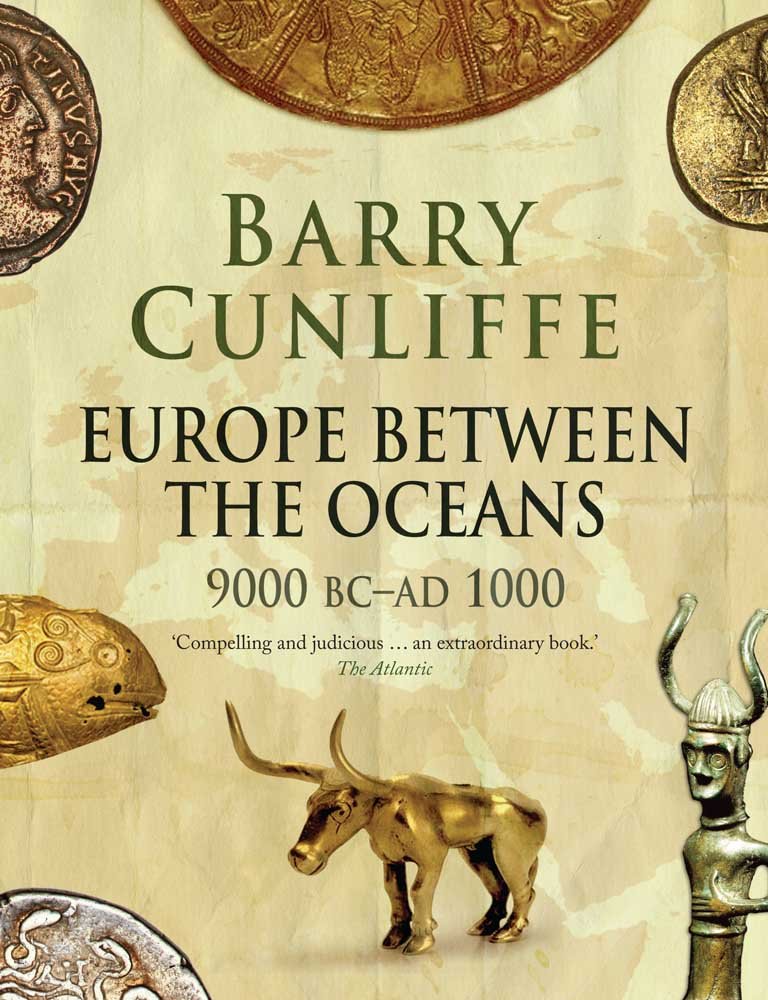Cunliffe, Barry. Europe Between the Oceans, 9000 BC – AD 1000. New Haven: Yale University Press, 2011.
The field of history has no shortage of biases in the subjects and evidence it prioritizes. Eurocentrism and its myriad racist offshoots remain perhaps the most insidious and notable, but every subdiscipline, region, and era has its own share of faults. One in particular that I have encountered (and to a degree absorbed due to the high volume of works I read in the field) is the focus of ancient European history on the Classical civilizations of the Bronze and Iron Age Mediterranean. The cultures of temperate and more northern Europe seldom appear in surveys of these millennia except when in conflict with more conventional “civilizations,” particularly Rome and the Greeks. My discovery of Barry Cunliffe’s ambitious ten thousand-year history of the entire continent, then, was a welcome one. Yet while Cunliffe for the most part delivered on my content expectations, his larger historical framework seemed much too taken with his focus on the long-term currents of human history.
A common theme in many Concerning History reviews in the past few years have been authors attempting to cover too-ambitious scopes for the length of their works. Ten thousand years of the history of an entire continent seems like it could only be described as such, yet Cunliffe is clever in his focus: rather than detailing all of European history, he focuses on the bigger picture, especially the role of geography, environment, and macrohistorical phenomenon like the movement of peoples or the growth of trade to guide his narrative. This approach allows Cunliffe to paint a compelling picture of Europe as a whole and its evolution across ten millennia as well as depending on the material culture that is both the bread and butter of the archaeologist’s trade and the only way to really appreciate how life was lived in any given era of history. Europe Between the Ocean’s plentiful color plates and maps only enhance this effect, introducing readers not only to underserved peoples of history but also to crucial causes of economic and state development not often considered in more conventional histories.
These strengths carry the day for the first two-thirds of Cunliffe’s work, yet as he draws closer to the dawn of conventional ancient history, they soon become a glaring weakness. I had already experienced some reservations in his introduction, when Cunliffe’s explanation of his own guiding historical methods argued that the large, centuries-long trends of history are all that really matter, with the actions of individuals and even whole polities not really mattering in the grand flow. To anyone with a sufficiently deep understanding of history, this statement is problematic, to say the least, but I hoped this would simply manifest as attention to often-ignored factors or intriguing alternate casualties, as indeed it did for many of the early chapters. Cunliffe’s bizarre insistence on inserting this principle into his narrative, however, went too far with laughable assertions that the Greek victories over the Persians mattered little for history (one can only imagine how the material culture of the Aegean would have changed, for one) or that Caesar, Pompey, Antony, Augustus, and other Roman luminaries were helpless actors with no agency, simply borne along on the waves of demographic expansion and economic reality. A closely related problem is Cunliffe’s penchant for describing outcomes as “inevitable” (a particular historical pet peeve of mine), even when the same causes result in different outcomes only centuries apart in his own telling. Even more odd is that these comments come precisely as Cunliffe abandons his earlier archeological focus to discuss the very history he supposedly discounts. Readers receive no treatment of the material culture of Classical and Helenistic Greece or Rome, even when it should be necessary for any discussion of trade, economy, or the character of European connection for centuries.
While my core hopes for Europe Between the Oceans were more than fulfilled in its novel approach to its early chapters, the confluence of its author’s flawed historical methods, abrupt switch in approach combined to ultimately make it too an overly-ambitious attempt at writing history. I still recommend it to any curious about the little-known cultures of pre-Roman Europe or the possible natural causes of well-known historical developments, but I remain in search of my definitive survey of ancient Europe.
